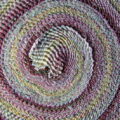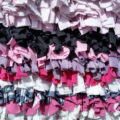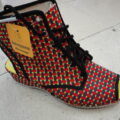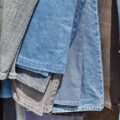Are clothes recyclable?
October 28, 2023Are clothes recyclable? The short answer is yes. Unwanted fast fashion can be made into many other things. Best of all is to keep the garment as it is and pass it on to someone else who really wants it, via a vintage store, consignment store, thrift stores, recycling bins or giving it to a friend. But even charity shops sometimes send clothes items to a recycling centre. If it is good quality, then the ideal is other garments.
The fabric itself can be saved and re-sewn into other new clothes. But it is more common for it to be shredded, turning it back into a mass of fibres, and those spun into new threads which are then re-woven into fabric, and brand new clothes created. It is far more common in the textiles industry than you may think, and you might be buying new clothes made from recycled fibre without knowing.
Almost everybody in the Western world owns, or has at one point owned, a pair of jeans. And many also have a denim jacket, dress, skirt, waistcoat or even hat. And so denim is a fabric that urgently comes under consideration when it comes to environmentalism. Denim fabric is made from cotton, which is good because it is a natural fibre that can biodegrade. However, it takes a lot of water to grow cotton, and it is usually sprayed with pesticides, which are not good for local wildlife. It also a lot of energy to process it into fabric. On top of this, the distinctive blue dye which colours most pairs of jeans has been known to leak into rivers in vast quantities. No fish enjoys blue rivers!
Are clothes recyclable? The Solution

Yumi Oyama sorts through and organizes clothes donated to Japan by listeners of the “Ron and Don” radio show at Naval Air Facility Misawa, Japan, June 24, 2011. MC1 Matthew Bradley, Public domain, via Wikimedia Commons
Many people do like to keep wearing their jeans until they fall apart, as they say that denim only gets better with age. Others get bored more quickly. What to do with jeans that are no longer your favourites? Nudie is one denim brand in the fashion industry who are helping blue jeans go green. They encourage customers to return their old jeans to the company when they have reached the end of their useful life. If they are high quality, they sell as pre-loved. They also have a repair service, and they cut up old jeans to make patches for other old jeans, or use the fabric for bucket hats.
It’s a great concept, but fashion brands like this can only handle so much old denim. Much more is sent to charity shops, or landfill. There is over a million tons of this and billion pounds of waste. But there is a Turkish company called Bossa who recover post-consumer denim waste (post-consumer waste means the objects that consumers discard after they have finished with them).
They cannot unravel denim that’s already been woven, it’s too time-consuming. Instead they shred it. But this means that, as you can imagine, the fibres are very short. Short fibres make very poor quality thread which is likely to snap. So they combine the old fibres with new cotton. The ratio is usually about 20% old to 80% new, which isn’t very high, but it is also possible to use 100% old fibres too. They, and other companies, are working on ways to introduce a higher percentage of re-used yarn into fabric and keep it looking luxurious.
Are clothes recyclable? The Question as an Artwork
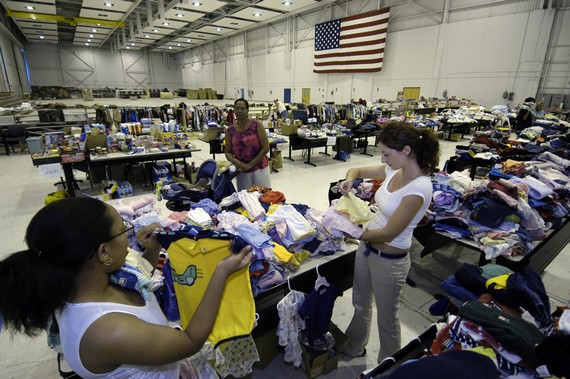
US Navy 050907-N-5328N-083 Volunteers sort through baby clothes at the Hurricane Katrina Evacuee Supply Depot, 2005.
U.S. Navy photo by Mr. Gary Nichols, Public domain, via Wikimedia Commons
And it’s not only denim that can be re-used or re-made. There was an artwork on show at the Design Museum by Christien Meindertsma in its 2017 exhibition, Fear and Love – Reactions to a Complex World which addressed are clothes recyclable. Piles of fluff in different colours were shaped into gentle cones and spotlit, resembling the heaps of spices at an Asian market or an Anish Kapoor exhibit.
But these little heaps were unwanted clothing, shredded as with denim but then carefully sorted by robot. You see, recycling denim has its problems but denim is universally made from either cotton, or cotton with elastane in it, for stretch. If it’s just cotton, it’s pretty straightforward. Cotton-elastane mixes are a little bit more tricky. But a garment like a jumper could be made of cotton, bamboo, wool, cashmere, acrylic, Angora, mohair… the list goes on. And while denim is almost always blue, jumpers come in a rainbow of colours. It’s really hard for manufacturers to separate all these different fibres and colours into like with like.
Cashmere Sweater into Carpet Underlay
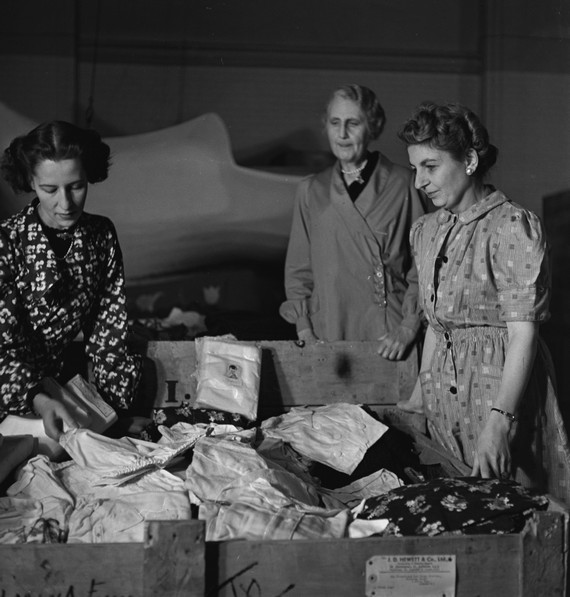
Clothes distribution – The Netherlands Emergency Committee, amalgated with the London section of the Nederlands Red Cross, 1943.
Onbekend / Publiek Domein, [onbekend], CC0, via Wikimedia Commons
There are definitely enough clothes donations of discarded pink cashmere sweaters, for example, to make a lot of nice new luxury ones. But it’s so tricky to identify and sort the fibres that what actually happens is that pink cashmere sweater is shredded and added to a heap of fabric that includes a baby-blue natural fiber lambswool cardigan and a dark green polyester pullover, for example. It’s all mixed together and compressed into a rough kind of felt. Which, as you can imagine, has a kind of sludgy colour with hints of shocking pink of smears of green. No designer on earth would want to make clothes out of this. Unless they were very avant-garde! So it is made into things that don’t matter, like carpet underlays, housing insulation, or blankets to protect furniture when moving house.
Are clothes recyclable? Yes, and Getting More so Every Year
Obviously, this is quite a waste and a shame. So Meindertsma looked at more sensitive textile recycling machines that could sort better. She also discovered that the machines could seem “confused” and appear to mis-sort the fibres quite often. But this was because the product was often mis-labelled. If it said “100% lambswool” it might, according to analysis, be only 85 percent lambswool and 15 percent nylon. These were often garments from well-know high street brands. However, garment manufacturing is very complicated when it comes to the supply chain. It is probably hard to known who signed off on the money-saving deception, and at which point. That’s another thing brands are working on too.
But anyway, to answer your question. Yes, clothes are recyclable. It’s complicated, but the technology to deal with textile waste at recycling centers is improving all the time.




